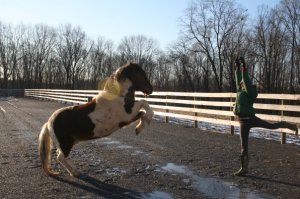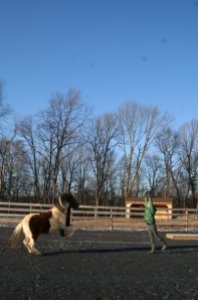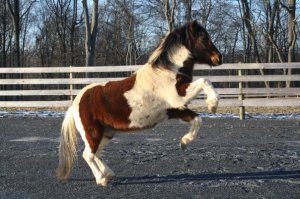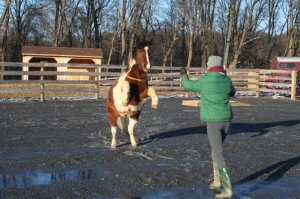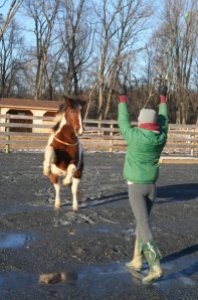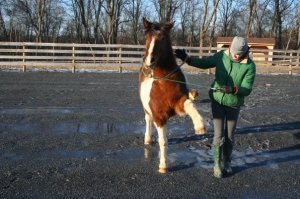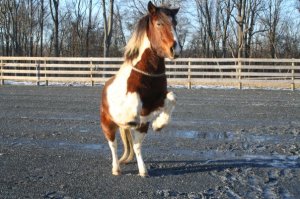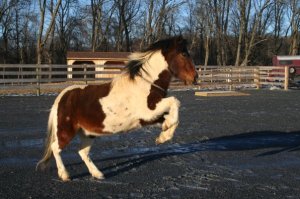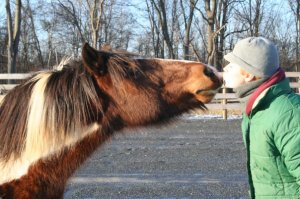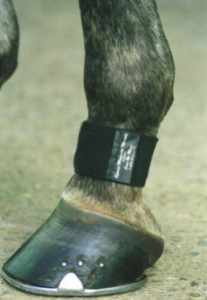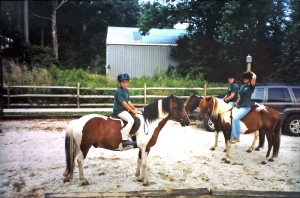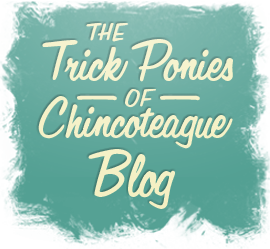Posts Tagged ‘assateague
The Wild Stallion
Here are some photos taken on January 31, 2010 of Minnow and I. Minnow is showing off his wild stallion rear. With each day he’s getting higher and higher – as he’s building more muscle and getting stronger. Enjoy!
Alex of Jandelo
 Meet Alex of Jandelo, Misty of Chincoteague’s trusty Dachshund side-kick. It seems as if all the great Chincoteague ponies have Dachshund side-kicks! Alex’s likeness was even featured on the cover of “Wagging Tales” – an album of dogs by author Marguerite Henry.
Meet Alex of Jandelo, Misty of Chincoteague’s trusty Dachshund side-kick. It seems as if all the great Chincoteague ponies have Dachshund side-kicks! Alex’s likeness was even featured on the cover of “Wagging Tales” – an album of dogs by author Marguerite Henry.
A friend sent me a link to photos of Misty of Chincoteague that appeared in LIFE magazine, June 10, 1957. The photos were taken as Misty was loading up and leaving her Illinois home as Author and owner, Marguerite Henry, said good bye. Misty was headed to Chincoteague in order to have her colt.
Of course I was immediately drawn to the photos of Misty and her pal Alex, as it reminds me so much of the special friendship that my own Chincoteague Minnow and Ammo the Dachshund share. (and just to be clear I did not become a Dachshund owner because of Misty – purely a coincidence). 
As I leafed through all of the LIFE magazine photos I fantasized how neat it would be to recreate many of Misty’s old photographs with Minnow (and Ammo too) for a book. Although when I showed my husband the photos of Misty inside of Marguerite Henry’s house (she apparently was only allowed in on Holidays like Thanksgiving and Christmas) – he didn’t seem to like my idea of recreating the photos so much!
 Anyway, enjoy these photos of Misty and Alex (with a few of Ammo and Minnow thrown in there too).
Anyway, enjoy these photos of Misty and Alex (with a few of Ammo and Minnow thrown in there too).
For more Misty of Chincoteague fun check out my post on the similarities that Misty and Minnow share!
Photos from LIFE Magazine
Maintaining Ringbone
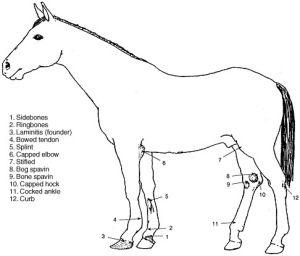 Lately I’ve been doing a lot of research into ringbone, because that is what Chincoteague Minnow was diagnosed with in 2008, and is the reason he was retired from competition and riding in general.
Lately I’ve been doing a lot of research into ringbone, because that is what Chincoteague Minnow was diagnosed with in 2008, and is the reason he was retired from competition and riding in general.
For anyone that doesn’t know, Ringbone is a bone growth in the pastern or coffin joint of a horse. In severe cases, the growth can encircle the bones, giving ringbone its name. Essentially ringbone is a form of equine arthritis. There are several reasons why horses can develop ringbone, I’m fairly certain that Minnow developed it due to poor confirmation (he has fairly upright pasterns) and the fact that for 4 years I competed him in a speed sport, Mounted Games. Although Minnow did develop ringbone in his left front, which is sort of contradictory to our sport, because the majority of the time we always make right hand turns – putting most of the strain on the right front leg. So I think that even though Minnow was involved with a physically demanding sport, he likely would have developed ringbone either way.
Some horses can continue to be ridden with proper maintenance, and there are several treatment options, although none can cure ringbone. One such option is joint injections, which I did try on Minnow at the suggestion of several vets. The pastern joint can be injected directly, typically with a form of corticosteroid and hyaluronic acid. For several months Minnow was on stall rest, and although I did see improvement it was never enough to continue riding him like I had hoped.
Personally I didn’t think it was right to continue to ride Minnow (by drugging him up) simply for my enjoyment. So now the only “maintenance” Minnow gets is proper barefoot shoeing and the occasional dose of bute (sort of like aspirin for horses) if he’s going to be doing something a little more strenuous like performing with me.
But as Minnow gets older (he turns 17 this year) I’ve begun to wonder if I’m doing enough to alleviate his pain? But at the same time I don’t want to dose him like crazy with supplements that he really doesn’t need. I’m sort of torn in both directions. He’s a hearty pony that was born wild, maybe less is better? I also read somewhere that light exercise is better for ringbone than letting the horse stand in one area a lot. Minnow is turned out daily, but maybe he needs more, perhaps I should be taking him on walking trail rides once a week or more?
So as I contemplate and research what is best for him I’m posting this question to all of my readers (or passerby’s) of this blog….Any Suggestions? Perhaps you’ve had/know a horse with ringbone…has anything worked for them?
As soon as I figure out this Ringbone dilemma I’ll have to move onto Equine Cushings – as my retired Dressage horse, Niatross, has been diagnoised with this illness. He’s not the first experience I’ve had with cushings though, my childhood pony, Oopsie Daisy, also had cushings in his later years.
Racehorse Minnow
In the fall/winter of 2007 Minnow had developed a slight lameness. I spent months trying to diagnosis the issue, xrays were inconclusive, farriers couldn’t find anything, flex and pinch tests revealed nothing. So I waited, hoping it was a very deep abscess like everyone else. (A hoof abscess is a localized bacterial infection in the sensitive structures of the hoof.)
So as Minnow gained more and more weight as most Chincoteague Ponies tend to do (some say they could live off a cement slab), I decided to exercise him anyway.
I took Minnow once a week to the Thoroughbred indoor pool. (ok well technically my mom took him for me most of the time as I was in my final semester of college – thanks mom!).
So once a week Minnow plodded his fat body slowly into the pool and huffed and puffed as he did laps about 1/4 of the speed the racehorses do it. He quickly became a favorite as he was quite a change of pace from the lanky and feisty young racehorses, not to mention he gave everyone kisses and handshakes afterwards.
Here’s a video of the cutest little racepony 🙂
Minnow in the News
A few days ago a fellow Chincoteague Pony lover like myself sent me an article from the July 20, 2001 Chincoteague Beachcomber newspaper. I was especially excited to receive this because it mentioned my Chincoteague Minnow!
In 2001 Minnow had just begun living (and earning his keep) at the Chincoteague Pony Center, this was 3 years before I ever met him.
Here’s the excerpt from the article that mentions Minnow:
Making his debut at the Centre and one of everyone’s favorites is Chincoteague Minnow, who was bought at the pony auction seven years ago. He was named Minnow because he was the “smallest, wimpiest, shrimpiest” pony sold that year, according to his former owner and buyer. Today he stands 13.1 hands tall, and is a “stout” pony, ready to carry any load. His gentle disposition makes him a favorite at riding lessons and pony rides alike.
I was especially intrigued by the terms “wimpiest” and “gentle disposition”. When Minnow came to live with me in 2003 I would probably have to say he WAS wimpy, but not in the normal sense. Minnow was fearful of a lot of things, sounds, strange objects, cameras – but he didn’t react the way a normal fearful horse would. Instead of spooking or acting out, he pretended his fears didn’t exist. He ignored them – turned his head, avoided contact. Hence where “gentle disposition” comes in to play. He was plodding through life complying to everyone’s wishes, giving pony rides, performing, being ridden, but I can only suspect he was living in fear – and he was very good at hiding it. I didn’t discover this extreme fear until Minnow developed a “runaway” behavior after I deem he likely just reached a point in his life where the fear got too great. Granted when he first lived at the Chincoteague Pony Centre he had not yet gone to the home in Harrisburg, Pa where lived in a neglectful home – so his “fear” may not have really been evident (or even noticeable) while he lived at the Pony Centre. But seeing that he was deemed “wimpy” even as a foal coming off the island in 1993, makes me believe that Minnow always had some sort of fear hidden away. I can envision him a tiny frightened foal, trying to hide from the mass of people. Who can blame him, wouldn’t you have some fear if you were suddenly plucked from your mom as a baby? Some foals at the auction rebel, put on a show of bucking and rearing, while others internalize their fear and stand motionless, unable to move. I think Minnow was one of the latter – for most of his life.
I like to believe that now he’s no longer consumed by his fear. Minnow is curious, he’s bright eyed, and he trusts me to keep him safe. I think a little bit of fear will always be with him, its in his nature, but I think he now knows that he doesn’t have to internalize it. Its ok to be scared, but confronting them is the only way to make them less “scary”.
I’m ever so grateful to have a copy of this article, I love learning more about Minnow’s past and where he was before me. I love how his life has circled back again and now we take yearly trips to the Chincoteague Pony Centre where he was and always will be a beloved favorite.
Read more about Minnow’s journey to find me here!

